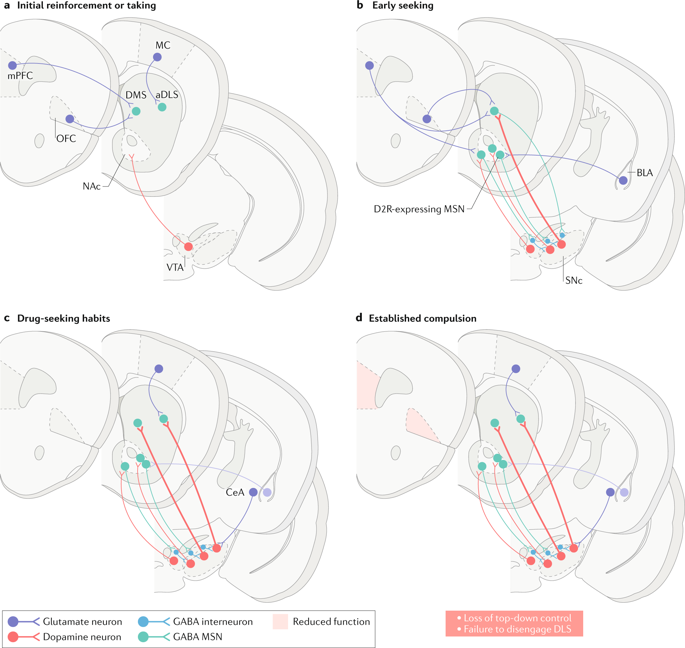当前位置:
X-MOL 学术
›
Nat. Rev. Neurosci.
›
论文详情
Our official English website, www.x-mol.net, welcomes your
feedback! (Note: you will need to create a separate account there.)
The transition to compulsion in addiction.
Nature Reviews Neuroscience ( IF 28.7 ) Pub Date : 2020-03-30 , DOI: 10.1038/s41583-020-0289-z Christian Lüscher 1, 2 , Trevor W Robbins 3 , Barry J Everitt 3
Nature Reviews Neuroscience ( IF 28.7 ) Pub Date : 2020-03-30 , DOI: 10.1038/s41583-020-0289-z Christian Lüscher 1, 2 , Trevor W Robbins 3 , Barry J Everitt 3
Affiliation

|
Compulsion is a cardinal symptom of drug addiction (severe substance use disorder). However, compulsion is observed in only a small proportion of individuals who repeatedly seek and use addictive substances. Here, we integrate accounts of the neuropharmacological mechanisms that underlie the transition to compulsion with overarching learning theories, to outline how compulsion develops in addiction. Importantly, we emphasize the conceptual distinctions between compulsive drug-seeking behaviour and compulsive drug-taking behaviour (that is, use). In the latter, an individual cannot stop using a drug despite major negative consequences, possibly reflecting an imbalance in frontostriatal circuits that encode reward and aversion. By contrast, an individual may compulsively seek drugs (that is, persist in seeking drugs despite the negative consequences of doing so) when the neural systems that underlie habitual behaviour dominate goal-directed behavioural systems, and when executive control over this maladaptive behaviour is diminished. This distinction between different aspects of addiction may help to identify its neural substrates and new treatment strategies.
中文翻译:

成瘾向强迫的转变。
强迫是吸毒成瘾(严重物质使用障碍)的主要症状。然而,只有一小部分反复寻求和使用成瘾物质的人存在强迫行为。在这里,我们将向强迫转变的神经药理学机制与总体学习理论相结合,概述强迫在成瘾过程中是如何发展的。重要的是,我们强调强迫性寻求药物行为和强迫性吸毒行为(即使用)之间的概念区别。在后者中,尽管有重大负面后果,个体仍无法停止使用药物,这可能反映了编码奖励和厌恶的额纹状体回路的不平衡。相比之下,当习惯性行为背后的神经系统主导目标导向的行为系统,并且当对这种适应不良行为的执行控制减弱时,个体可能会强迫性地寻求药物(即,尽管这样做会产生负面后果,仍坚持寻求药物) 。成瘾不同方面之间的区别可能有助于识别其神经基质和新的治疗策略。
更新日期:2020-03-30
中文翻译:

成瘾向强迫的转变。
强迫是吸毒成瘾(严重物质使用障碍)的主要症状。然而,只有一小部分反复寻求和使用成瘾物质的人存在强迫行为。在这里,我们将向强迫转变的神经药理学机制与总体学习理论相结合,概述强迫在成瘾过程中是如何发展的。重要的是,我们强调强迫性寻求药物行为和强迫性吸毒行为(即使用)之间的概念区别。在后者中,尽管有重大负面后果,个体仍无法停止使用药物,这可能反映了编码奖励和厌恶的额纹状体回路的不平衡。相比之下,当习惯性行为背后的神经系统主导目标导向的行为系统,并且当对这种适应不良行为的执行控制减弱时,个体可能会强迫性地寻求药物(即,尽管这样做会产生负面后果,仍坚持寻求药物) 。成瘾不同方面之间的区别可能有助于识别其神经基质和新的治疗策略。











































 京公网安备 11010802027423号
京公网安备 11010802027423号